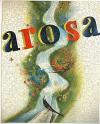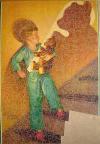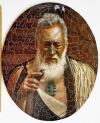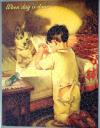The 1930s ushered in the Great Depression and the greatest jigsaw puzzle craze in U.S. history. Many skilled workers were thrown out of work by the depression and thousands turned to producing hand-cut wood puzzles in their attics and garages. Whereas the 1909 era was dominated by female cutters, the 1930's was dominated by men. Because wood puzzles were considerably more expensive than die cut ones, small puzzle lending libraries sprang up along with sales of new hand-cut puzzles. With quality plywood readily available and power-driven scroll saws selling for as little as $5, most puzzles produced were interlocking and some were notable examples of how intricate and complex a puzzle could be cut (see Gloria on display). With times hard and few able to afford travel, pictures selected tended to reflect a yearning for the exotic and foreign. By the late 1930's the puzzle craze had abated, the lending libraries closed and most cutters had moved on to other pursuits.
One of our most spectacular puzzles, cut for an exclusive lending library operated by Josephine Flood on Park Avenue in NYC in the 1930’s. While the cutting is excellent with 96 figure pieces, so is the artwork by a little-known artist named A. Carigret, resulting in a great puzzle and fun to assemble despite its size.
One of the most extraordinary examples of a complex (multiple piece) figure we have seen is the 43-piece sailing ship in this puzzle. Note that many of the kerf (cut) lines within the figure emphasize the sails and markings of a ship. In addition, Towne also cut the title, “Breeze!” into the puzzle, his signature piece of the arching cat, several other appropriate figure pieces and much color line cutting. The picture by the old Dutch master, Jacob Van Ruisdael, may not be very interesting but the cutting is exceptional!
This was one of my favorites as a boy and is still a family favorite today. Identified as an Arteno puzzle made in the early 1930's from its scroll style cutting used by some of the best makers of that era, and near total cutting along color lines. Many pieces have shapes which are esthetically pleasing. As the “little boy” in the family back in the early 1940's, I was first assigned the checkerboard to assemble. Took me two tries to assemble it’s 10 pieces! The artist is, of course, Norman Rockwell.
One of the more frustrating aspects of running a puzzle lending library in the 1930's was insuring that the puzzle came back complete. Ideal Picture Puzzle Co. of Chattahoochee, GA developed a novel solution to this problem. The puzzle shown here was cut with 8 very long edge pieces (the painted portions of the plywood extending beyond the picture) and the rest of the puzzle cut to interlock tightly into the 8 edge pieces. The Company then designed a box to serve as a mailing envelop for the assembled puzzle. When the puzzle arrived back at the Company all assembled, missing pieces would be obvious and the errant borrower fined accordingly. Unknown artist here depicted the exhaustion and suffering of a plains native American.
Famous die cut advertising puzzle made in 1930's with 6 figures to promote Esso products. Artist is Dr. Seuss, author of wonderful illustrated books for children which so many of us read to our children. During the Great Depression, many companies resorted to using advertising puzzles as premiums to generate sales. This is the only cardboard puzzle in this exhibition of wood puzzles, but I thought it might appeal to children here visiting their grandparents.
Our largest and most intricate Falls puzzle with over 310 figure pieces for a ratio of 1 figure piece for every 2.7 puzzle pieces, significantly higher than the 1:4 ratio in most Falls puzzles. Note the maker's signature piece of a woman falling on her bottom in the lower right corner, cut into every Falls puzzle. The cut-away section in the lower right corner suggestive of stairs is unusual for a Falls puzzle, the result of cutting away wording promoting Eveready flashlight batteries. Eveready used over a dozen such images to advertise its batteries in the 1930's. Artist is Russell Sambrook.
This unusual puzzle came in a large batch of puzzles from Christchurch, NZ, all made by the same person, seller’s grandfather, Charles Hart, in the 1930's. Ill with a failing heart, Mr. Hart cut 40 puzzles for his wife to establish a lending library after his death and earn some money. She never did establish the library and the puzzles arrived here in their original cellophane having never been used. Artist’s signature is illegible; art date is 1908.
A prime example of irregular (scalloped) edges and attachment of at least 10 stickers to the picture before cutting. This may well be the first use of stickers making a "collage puzzle". Like more modern puzzles it also contains a "signature piece" or special figure piece identifying the maker or brand, in this case the letters "NF" for Nu-Friend. This piece was critical in identifying the maker/brand because the puzzle was misboxed when we acquired it. Artist unknown.
A great puzzle made by Allen Winsor, Brookline, MA brilliantly cut along color lines. Artist is Francis Tipton Hunter; print was used for an Eveready flashlight battery ad much like the print for Little Bear Behind in this exhibition.








